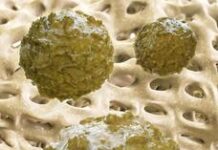ADMEC-O is the first prospective randomised controlled study reporting results for adjuvant treatment with immune checkpoint inhibitor (ICI) in patients with Merkel cell carcinoma. At a median follow-up of approximately 2 years, median disease-free survival (DFS) was not reached, but the hazard ratio (HR) between treatment and observation was 0.58, favouring the nivolumab group. The 12- and 24-months DFS rates in the nivolumab group were 85% and 84% compared with 77% and 73% in the observation group.
However, overall survival (OS) events rates are not mature enough. The findings from the interim analysis of ADMEC-O study suggest that adjuvant treatment with ICI is clinically feasible in this area of unmet medical need. The results are published by Prof. Dirk Schadendorf of the Department of Dermatology, University Hospital Essen in Essen, Germany, and colleagues on 11 July 2023 in The Lancet.
The authors wrote in the background that ultraviolet light-mediated mutagenesis and viral carcinogenesis associated with Merkel cell polyomavirus explain the notable immunogenicity of Merkel cell carcinoma. Despite immunogenicity, Merkel cell carcinoma is very aggressive. Even after complete resection and radiation, relapse rates are high. ICIs (avelumab and pembrolizumab) showed clinical benefit in patients with advanced Merkel cell carcinoma. To date, no systemic adjuvant treatment has been established.
ADMEC-O is a randomised, open-label, two-arm, phase II study, conducted in 20 academic medical centres in Germany and the Netherlands. It is an investigator-initiated study conducted to assess the clinical benefit of nivolumab compared with observation in patients with completely resected Merkel cell carcinoma. Patients were randomly assigned 2:1 to receive nivolumab 480 mg every 4 weeks for 1 year, or observation, and stratified by stage (American Joint Committee on Cancer stages 1–2 versus stages 3–4), age (<65 versus ≥65 years), and sex.
Landmark DFS at 12- and 24-months was the primary endpoint, assessed in the intention-to-treat populations. OS and safety were secondary endpoints. The planned interim analysis was triggered when the last-patient-in was followed-up for more than 1 year.
Between 1 October 2014 and 31 August 2020, 179 patients were enrolled of whom 116 (65%) with stage 3–4, 122 (68%) ≥65 years, and 111 (62%) were male. Stratification factors were balanced across the nivolumab group that comprised 118 patients and observation group that included 61 patients. Adjuvant radiotherapy was more common in the observation group.
At a median follow-up of 24.3 months, median DFS was not reached (between-groups HR 0.58, 95% confidence interval 0.30–1.12). DFS rates in the nivolumab group were 85% at 12-months and 84% at 24-months, and in the observation group were 77% at 12-months and 73% at 24-months.
OS results were not yet mature. Grade 3–4 adverse events occurred in 42% of patients who received at least one dose of nivolumab and in 11% of patients in the observation group. No treatment-related deaths were reported.
The authors commented that for the final analysis expected to occur in autumn 2024, the length of the follow-up period might, despite its prolongation to 4 years in 2020, not be sufficient to capture all events needed to report updated median DFS and OS.
The data from this interim analysis of ADMEC-O show that adjuvant nivolumab is feasible and safe; it might provide clinical benefit in the form of prolonged DFS in patients with completely resected Merkel cell carcinoma. The results provide a promising signal of efficacy to continue ongoing randomised studies in this area (I-MAT, ADAM, and confirmatory STAMP); however, the statistical assumptions for the case number calculations in these studies should be critically reconsidered.
In an accompanied comment, Prof. Philippe Saiag and Dr. Astrid Blom of the Department of General and Oncologic Dermatology, Ambroise Paré Hospital, Université de Versailles Saint-Quentin-en-Yvelines, Université Paris-Saclay in Paris, France congratulated the authors for conducting a study in such a rare cancer and in the adjuvant setting. However, they warned that multiple issues should be addressed before using this strategy routinely.
Waiting for the study maturation with longer follow-ups is needed and for the results of other ongoing studies in this population investigating adjuvant avelumab or pembrolizumab. It is an unblinded study without a central review of images. Apart from nivolumab treatment, the protocol did not require similar management in the treatment and observation groups. It is not a typical superiority study, but an exploratory phase II study in an area without any reference for efficacy, which included a relatively low number of patients, thus lacking statistical power. Previous adjuvant or concurrent adjuvant radiation was permitted in both groups, but more patients received it in the observation group than those in the nivolumab group.
The treatment of patients who progress during or a few months after adjuvant treatment is particularly challenging considering the limited number of alternatives. Cytotoxic chemotherapies are frequently effective initially, but responses are of short duration and toxicity is high. The role of adjuvant radiotherapy in addition to adjuvant ICI should also be investigated according to the editorialists.
This investigator-initiated study was supported by Bristol Myers Squibb. The funder of the study provided nivolumab free of cost and provided third-party funding for study coordination, documentation, monitoring, and data management. The staff of Alcedis was involved in data collection and analyses.







